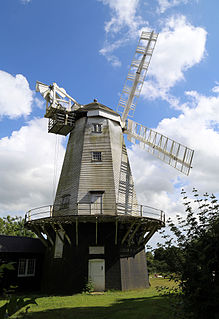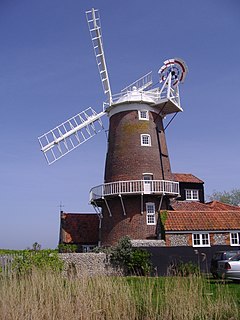
Heckington Windmill is the only eight-sailed tower windmill still standing in the United Kingdom with its sails intact.

Upminster Windmill is a Grade II* listed smock mill located in Upminster in the London Borough of Havering, England. It was formerly known as Abraham's Mill and was in Essex when built. It has been restored and is a museum open to the public at selected times.

King's Mill or Vincent's Mill, Shipley, West Sussex, England, is a smock mill built in 1879 which has been restored and was open to the public until its closure on 19 July 2009.

Denver Windmill is a Grade II* listed tower mill at Denver, Norfolk, England.

Great Bircham Windmill is a Grade II listed tower mill in Great Bircham, Norfolk, England.

Burnham Overy Staithe Windmill is a Grade II* listed building tower mill at Burnham Overy Staithe, Norfolk, England which has been converted to holiday accommodation.

Caston Tower Windmill is a grade II* listed tower mill at Caston, Norfolk, England which is under restoration. The mill is also a scheduled monument.

Cley Windmill is a grade II* listed tower mill at Cley next the Sea, Norfolk, England which has been converted to residential accommodation.
Stanford Windmill is a Grade II listed tower mill in Stanford, Kent, England that was built in 1857. It stands on Kennett Lane in Stanford.

Ovenden's Mill or Mockett's Mill is a grade II* listed tower mill at Polegate, East Sussex, England which has been restored and is open to the public.

Terling Windmill is a grade II listed Smock mill at Terling, Essex, England, which has been converted to residential use.

Thelnetham Windmill, also known as Button's Mill is a Grade II* listed tower mill constructed of brick. The windmill is located at Thelnetham, Suffolk, England. It was built in the early nineteenth century to grind wheat into flour. Thelnetham windmill worked by wind power until 1924, latterly on two sails, after which it became derelict.

Gazeley Mill is a tower mill at Gazeley, Suffolk, England which has been converted to residential accommodation.

Pakenham Mill is a Grade II* listed tower mill at Pakenham, Suffolk, England which has been restored and is maintained in working order.

Buttrum's Mill or Trott's Mill is a Grade II listed tower mill at Woodbridge, Suffolk, England which has been restored to working order.

Aslacton Mill is a Grade II listed tower mill at Aslacton, Norfolk, England which is derelict.

Union Mills or Roy's Mills are a Grade II listed combined tower mill and watermill at Burnham Overy, Norfolk, England which has been converted to residential accommodation.
Mill Lane Mill is a Grade II listed tower mill at Carbrooke, Norfolk, England which has been conserved with some machinery remaining.

Jay's Mill, Button's Mill or Victoria Road Mill is a tower mill at Diss, Norfolk, England which has been truncated and converted to residential accommodation.

Garboldisham Mill is a Grade II* listed post mill at Garboldisham, Norfolk, that has been restored.
The illustrated History of Hoxne. 2006. Stephen Govier.





















